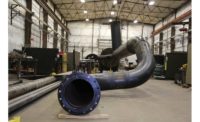Our annual survey of specialty contractors shows it’s a good time to be a specialty firm in the Midwest. The two top-rated firms each booked more than $1 billion in regional revenue last year, and our smallest respondent still posted $5 million in work.
“It’s a great economy,” says Chuck Goodrich, president of Gaylor Electric of Indianapolis, which ranked 20th overall and seventh among electrical contractors this year. Goodrich is also the national chair of the Associated Builders and Contractors. “The Midwest is booming right now,” he says. “Our construction backlog for the Midwest is up to 40%. For the entire country, that backlog rate is around 20%.”
A steady stream of manufacturing facilities and the expansions of existing ones as well as demand from both traditional power generation, renewable generation and utility work led to much of that success. Overall, our 55 respondents did more than $9 billion of work in the Midwest.
ENR Midwest 2017 Top Specialty Contractors
It’s important to note that ENR has expanded the region this year to add the states of Iowa, Kansas, Kentucky, Minnesota and Nebraska to the “old” region that comprised Illinois, Indiana, Michigan, Missouri, Ohio and Wisconsin. The new 342,000 square miles of construction markets certainly helped the bottom lines of this year’s submitters, but even companies that did business entirely in the old region saw an increase in revenue this year.
Libertyville, Ill.-based Aldridge Electric Inc. does much of its work in its home state ($232 million of its $303.9 million). Aldridge is ranked sixth overall and second among electrical contractors. Substation electrical is a big focus of Aldridge’s work, and Tom McLinden, company president, says that the shutdown of the Illinois state government in July over budget issues did affect business.
“It delayed things for the department of transportation, airports and other authorities,” McLinden says. “A lot of the agencies are looking at different procurement methods now because of that. They are just starting to talk about design-build. That budget uncertainty definitely has delayed work.”
Aldridge completed some major state and municipal projects this year, including the $280-million improvement of the Chicago Transit Authority’s 95th Street terminal, work at both Chicago airports and work that was shut down for about two weeks on the Illinois Tollway.
“Competition is still very tough in the overall marketplace,” McLinden says. “We have got to make the investment into understanding how to prefabricate and become very modern with the way we handle our materials and put some of the work into a prefab environment to make a better, safer environment for our people in the field.”
Prefabrication proved a major business driver for several survey respondents, particularly in electrical and plumbing system design. Both general contractors and clients are driving the increased use of prefabrication, along with the desire by specialty firms to deliver a safer, more controlled work environment. Gaylor has an enterprise-wide goal to reach 5% of its total worker-hours with prefabricated work.
“We’re trying to get 150,000 worker-hours out of our fabrication shop … out of a 3 million worker-hour company,” Goodrich says. “We have worked very diligently on that. This year we have just over 3%. We think that 3% actually saves on the job while helping the customer on the time and the schedule. That’s in both our Midwest and Southeast fab shops.”
Gaylor’s focus has been growing the organization, meeting client demands and finding ways to tackle the regional backlog. Goodrich says that his company’s manufacturing plant work, including the $248-million expansion of Logan Aluminum’s plant in Russellville, Ky., has been a strong revenue driver as well.
“Even in the middle of last summer we anticipated manufacturing taking off in the Midwest,” he says. “People talk about auto sales being down, but our auto design-build work in automotive is growing. If you go into Kentucky and Tennessee, there is work on large-scale plants in those markets.”
Updating the Midwest electrical grid has been a business driver for both Aldridge and Gaylor. Gaylor’s utility substation group has consistently grown and been a big part of its regional success. Goodrich says most of the group’s personnel is in Florida right now investigating the repairs needed after Hurricane Irma. The company’s substation work with American Electric Power has given it the experience and know-how to be helpful in areas hit by hurricanes.
Solar power generation, and its connection to substations, has been a healthy, growing part of Gaylor’s business as well.
“The main concern with solar, from our perspective, has been getting paid,” Goodrich says. “That project Minnesota was a big deal ($85 million in claims from a planned Aurora solar farm) with solar companies going out of business, but if you get the right client, it’s a strong, contributing part of the business.”
Goodrich says Gaylor has even asked for money up front from some solar clients. “It’s great work and good for us and the grid, but we have to make sure.”
The health care sector provided many of the top projects of Midwest survey respondents. Many companies noted that as their clients and designers plan more compact hospital buildings, they simultaneously desire space for more patients, which has resulted in an ever-shrinking space for M/E/P systems. Building information modeling and prefabrication are being used more often to make it all fit.
“Customers want more building delivered faster, and taking design from BIM to prefabrication gives us a leg up,” Goodrich says. “[General contractors] and clients look at how you improve production, the value you bring to the table. Essentially [asking] ‘Can you get it built to our schedule?’ They are willing to pay more, which they were not five years ago.”






Post a comment to this article
Report Abusive Comment